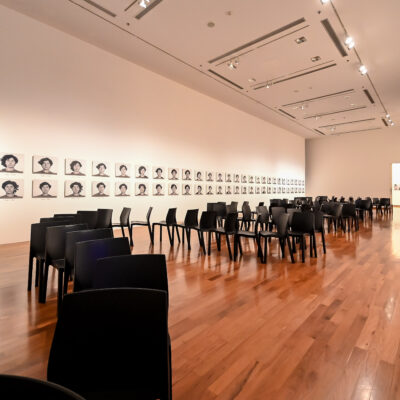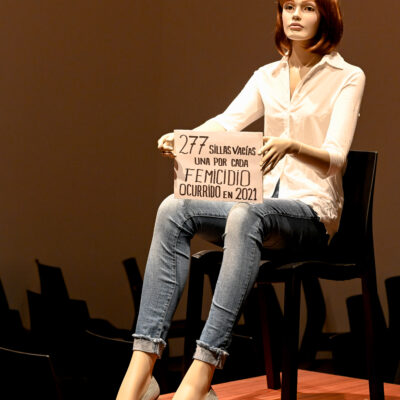Curating Exhibitions During the Pandemic*
During 2020, in the pressing context of the pandemic and global isolation, I was Chief Curator of the 12th Mercosur biennial, which has been organized since 1997 by the city of Porto Alegre, Brazil. Entitled Feminine(s). Visualities, Actions, Affects, the biennial was going to open on April 16, 2020. But on March 13, the closures and sanitary isolations began in Latin America and in the world. Our greatest effort at that time was to make sure that the artists who were already in Porto Alegre returned to their countries and that those who were going to travel that weekend did not. The following week, all airports were closed. We managed to prevent the artists from having to stay in Porto Alegre for six months.
As curator with responsibility for the entire biennial structure, I had to answer an urgent question: what did “curating” a feminist biennial mean in the context of the pandemic? There were critical moments and coming to agreement in the curatorial team was not easy. My responsibility towards the production teams and towards the artists was pressing. While the Metropolitan Museum and the Museum of Modern Art in New York canceled the contracts of their pedagogical teams, while the artists could not go to their workshops or support their economy since their private classes and the art market had been suspended, I felt that curating was, more than ever, “caring”. Seen in retrospect, the change we made with respect to the original project was surprising when, faced with the impossibility of knowing when and if we could open the physical biennial, we decided to transfer it to digital media. This decision made it possible to maintain the contracts of the entire production team for even longer than what had been planned for the face-to-face biennial. Maintaining the contracts of the artists was also made possible.
A week after the isolation began, I wrote to all the artists to ask them how they were doing. The responses were moving. The need to establish contact was strongly felt. So, we proposed that they send us a short video made with their cell phone telling where and how they were, what work they were going to present at the biennial, what relationship they found between their work and what they were experiencing. The files arrived by WhatsApp from different continents. Thus, an “archive of affects” was created that has been uploaded to the web since the end of March. This was an early, personal, and emotional archive.
Within the curatorial team, we began an internal debate that would allow us to critically analyze what was happening and relocate our practices. In such a context, it was clear to us that the transfer of the biennial to the web would include the editorial program. We published a journal in digital format, the presentations of the international seminar that we planned to hold at the beginning of April at the Federal University of Rio Grande do Sul, organized together with the Fundação Bienal do Mercosul – Bienal 12 Porto Alegre; Instituto de Artes, Universidade Federal do Rio Grande do Sul, UFRGS; Visual Arts Seminar, Universidade Estadual do Rio Grande do Sul, UERGS; and the Center for Latin American Visual Studies, The University of Texas at Austin, CLAVIS / UT. We published online all the papers in their original language (Portuguese, Spanish and English), as well as the catalog in a trilingual version.
More than 70 artists participated in the biennial, including several collectives. The presence of Afro-Latin American artists gave visibility to what, until then, had been invisible. Once all the art works were accessible online (including all the videos), the public program was organized through live meetings and laboratories. The educational program included 12 proposals that created different ways to explore the online biennial.
Caring is a central word in feminist studies. Family care, care of the elderly, of the house – predominantly the responsibility of women – took on an unexpected meaning for the curatorial practice. Curating was, in the experience of the pandemic, caring.
I want to add to this complex experience an epilogue that also allows us to think about the conditions of art in the new global context. Among the artists participating in the biennial was Esther Ferrer (San Sebastian, Spain, 1937), a Basque artist who lives in Paris, and who has been one of the central figures of artistic feminism since the seventies. Because it had been impossible to physically present her work at the biennial, I had the opportunity to do so in Buenos Aires, in the exhibition When the World Changes. Questions about art and feminisms I curated at the Kirchner Cultural Center. Among Esther Ferrer works, the most impressive was the one that she made first in Spain, in 2016, which was adapted to the Argentine context in 2021. It is an installation that brings together as many chairs as femicides happening during the time that the work was being exhibited. When the exhibition opened, on March 4, 2021, there were 41 empty chairs; in October, when the exhibition ended, 233. Each chair represents a murdered woman. The chairs came out of the exhibition space in which they were originally installed and filled the adjoining room. The work placed before us this traumatic presence-absence relationship. Let us also remember that during isolation domestic violence increased and that many women were forced to live with their aggressors. The art and the exhibitions were spaces for visibility and reflection on the global and local conditions that marked the world during the pandemic.
- Esther Ferrer, Installation with Chairs, Table and Mannequin, 2016-2021 /Photo: Manuel Pose Varela / Centro Cultural Kirchner
- Esther Ferrer, Installation with Chairs, Table and Mannequin, 2016-2021 /Photo: Manuel Pose Varela / Centro Cultural Kirchner
- Esther Ferrer, Installation with Chairs, Table and Mannequin, 2016-2021 /Photo: Manuel Pose Varela / Centro Cultural Kirchner
- Esther Ferrer, Installation with Chairs, Table and Mannequin, 2016-2021 /Photo: Manuel Pose Varela / Centro Cultural Kirchner
By Andrea Giunta, CONICET / UBA
*Links to the curatorial statement, curatorial team, artists, publications and activities online have been listed at the end of the article, as well as the link to the exhibition – When the World Changes – that includes a dossier in English and Spanish.
Document:
Curatorial Statement
Entitled “Feminine(s): visualities, actions and affections”, this biennial poses a question that points to the tension at the core of contemporary democratic culture: participation in society on the basis of “difference” understood— as Denise Ferreira da Silva puts it — as multiplicity rather than separation.
It looks as well to the questions Nelly Richard asked in her book Masculino/Femenino (1993) in the context of democratic transitions in Latin America. Her questions question the social place of the feminine, its constructions and gaps, and the radical departure from exclusive binary logic. These questions are as relevant as ever at a time when feminism is revisiting agendas and still unmet goals – first formulated in the sixties and voiced again in the nineties – while also responding to a series of pressing issues: growing violence against women and LGBTT+ collectivities; rising poverty and other systems of exclusion and discrimination; and worldviews that imperil the planet’s natural resources.
This biennial attempts to devise a contract of sensibility, a zone to exchange visualities, actions, and affects, and confirm the bounties of democratic life without ignoring its complexities.
Feminine(s) underscores creativity’s ability to push limits and constraints. It is inspired by the poetic words of Carolina Maria de Jesus, an Afro-Brazilian peasant, poet, and chronicler, who insisted on finding room between paid working and taking care of her children to write. She wrote in the fertile terrain of the Brazilian favela and despite the limitations imposed by (post)colonial racial violence. “Until the rain has stopped” is what she wrote on pages where words and images would create territories of potential freedom.
The act of writing explores the limits that circumstances impose on language. Writer Clarice Lispector was likely alluding to the conditions surrounding creation when she spoke of the task of making the way through impossibilities: “I cannot write everything I know,” she wrote, while also speaking of the “luxury of silence.” More than the obviousness of the senses, displaced at a time when they have been reduced to commonplace – to flat communication – the biennial’s exhibition layout is geared to careful reading by an interpretative community capable of tackling a complex mesh of sensibilities and discourses that embrace dissent as springboard of argumentation and deliberation. Because, as we know, we must speak and explore different ways of naming things to avoid blanket classifications.
Feminine(s) focuses on the proposals of female artists and of all non-binary, gender-fluid, and non-normative sensibilities, especially those that come out against the most varied forms of violence. It is about getting involved with the aspirations of the majorities that many works direct us toward, including artists of African or Indigenous descent, whose presence continues to incite critical reflections in an art world that is still resoundingly exclusive. It is about listening carefully and taking on everything that the stereotypes marginalize. All voices, with their heterogeneous visions and revisions, constitute culture.
Feminine(s) expands with the proposals of artists, regardless of gender, who, as partners or allies, share the desire for a less gender oppressive and discriminatory social order. There are many art forms that aspire to design a new symbolic and cultural horizon, where gender differences do not translate into inequality or subalternity. Changes require cross-sectional coalitions of identities that enrich one another thanks to overcoming difference. All stories need to be told and spread so that narratives become plural.
Feminine(s) is enriched by the creations of those who work with traditionally feminine materials and techniques. The creativity at play is to be found in conceptions of the common in a set of life experiences and everyday stories that must be heard as voices of diversity without differences. Experiences that expand the expression of a community contribute to conversation and exchange, to the much-needed reconstruction of a social fabric scarred by abuse and precarity. Such interaction gives rise to exchanges from which we can begin to imagine other forms of knowledge. All languages belong to us, without hierarchy of value or segregation of content.
Feminine(s) aspires to share the collective exercise of inventing new ways of doing, saying, thinking, and creating – a platform, a forum, a chorus of many forms of expression and ways to listen. It intends to act as a space where the traditionally exclusive structure that regulates the art world’s symbolic and cultural representations mutates. The biennial’s educational component is key to creating territories of exchanges and debate, gatherings of the many audiences that will create their own biennials. The biennial envisions itself as a space of collective celebration, a space to think and create together, to confront, with critical imagination, the challenge of strengthening a democratic pact that expands and diversifies the very shape of the citizenry.
Andrea Giunta
Links to the Biennial Online Archive
- Curatorial Statement
https://en.bienalmercosul.art.br/bienais/12%C2%AA-Bienal-do-Mercosul
https://www.bienalmercosul.art.br/online
- Curatorial Team
https://www.bienalmercosul.art.br/curadoria
- Artists
https://en.bienalmercosul.art.br/bienal-12-artistas
- Affects Archive
Publications
https://www.bienalmercosul.art.br/publicacoes
- Jornal
https://www.bienalmercosul.art.br/bienal-12-jornal
https://21cf08b2-90b0-4b83-97f9-807117bee408.filesusr.com/ugd/2468f7_c72c1f38921848bda8eeb0e1bb1c3427.pdf
- Internacional Seminar
https://21cf08b2-90b0-4b83-97f9-807117bee408.filesusr.com/ugd/af02ce_25e71233bb4b4c42877ad2ac1b95b75b.pdf
- Catalogue
https://www.bienalmercosul.art.br/_files/ugd/ae5dfe_d622ffbee4e24c2188de308b1ef3f404.pdf
Educative Program
- Propositions
https://www.bienalmercosul.art.br/bienal-12-proposicoes
- Lives and Laboratories on Line
- Kehinde Territory
https://www.bienalmercosul.art.br/post/territ%C3%B3rio-kehinde
- Encounters in Kehinde Territory
https://www.bienalmercosul.art.br/post/mem%C3%B3ria-bienal-compartilhar-saberes-construir-juntos
- Stations: Encounters pre-Biennial
https://www.bienalmercosul.art.br/post/semin%C3%A1rio-arte-feminismos-e-emancipa%C3%A7%C3%A3o
https://www.bienalmercosul.art.br/post/33%C2%BA-festival-de-arte-da-cidade-de-porto-alegre
https://www.bienalmercosul.art.br/post/nosotras-proponemos
https://www.bienalmercosul.art.br/post/territ%C3%B3rio-kehinde
- Exhibition When the World Changes. Questions on Art and Feminisms, Kirchner Cultural Center, Buenos Aires








